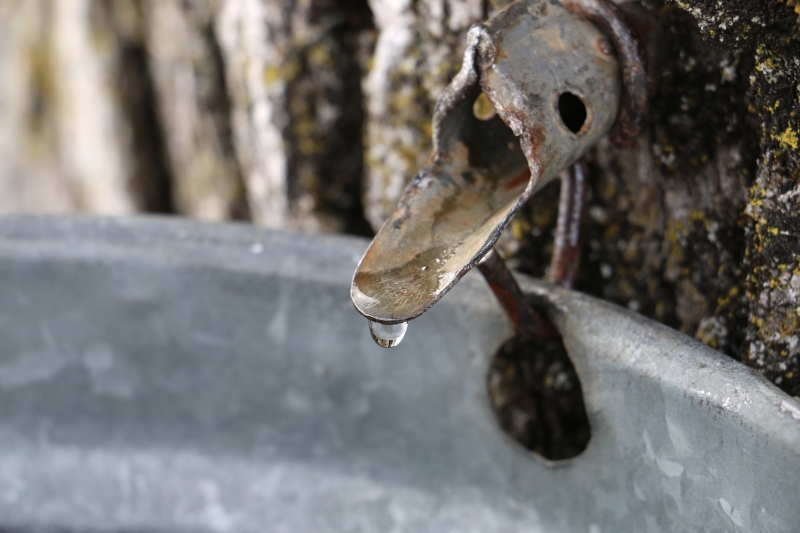
Flowing Sugar Maple Sap. Photo: Nature Up North
Got Gas?
Some foods give you gas, but this is the time of year when gas gives you a really delicious food. Maple syrup, which is nutritious enough to be listed by the USDA as a food (I say it deserves its own Food Group designation), is gas-powered. Carbon dioxide-powered, to be specific. If it wasn’t for a bunch of little gas bubbles in the xylem tissue, maple sap would not flow. Who knew that wood was carbonated?
A mere ten or so years in the past, science was at a loss to explain what causes maple sap to run. I always like it when people who are smarter and better-paid than I am don’t have the answer, either. We all know that below-freezing nights and warm days lead to sap flow. But it wasn’t until recently that the mechanism behind sap flow was understood.
Throughout sugar maple’s range, maple production has been economically important since Native Americans first taught European settlers how to gather maple sap to make syrup and sugar. Back then it involved placing red-hot stones into containers of sap to boil it down. We’re all thankful that technology has improved. Today’s maple producers have reverse-osmosis units, vacuum pumps and efficient high-capacity evaporators.
Aside from maple, very few tree species have a spring sap run. Birch and butternut are exceptions, but their roots generate pressure that forces sap upward, which is not the case in maples. It turns out maple sap flow is due to the way its wood interacts with freeze-thaw cycles. In biology we learned that wood, or xylem, is responsible for upward transport of water and dissolved nutrients, while sugars move down through the phloem, the outermost layer of cells. Fortunately for us, xylem “misbehaves” during the spring sap run, ferrying sugars upward where we can get to them. Later in the season, xylem casually returns to the textbook model, acting as if nothing unusual happened.
Xylem is composed of several types of cells, including vessels to transport liquid, and fiber cells to provide strength. Unlike most trees, maples have fiber cells which are partially gas-filled. Carbon dioxide and other gases in those fibers are critical to generating flow because they dissolve in sap. The geyser that results when we open a seltzer bottle (especially a warm one) too fast is a reminder that plenty of carbon dioxide can dissolve in water. If that bottle is icy cold, the risk of a gusher is low because cold water holds more dissolved gas.
During the night, gases in fibers shrink as they cool, eventually dissolving into sap in the vessels. This contraction of gases causes the tree’s internal pressure to drop, creating a suction that draws sap up from the roots. As the temperature warms in the morning, gases bubble out of solution and expand, increasing the tree’s internal pressure and forcing sap out the tap hole at about 15 pounds per square inch (psi) on average, occasionally up to 40 psi.
Rather than flowing up from the roots and out the tap during the day as was once commonly thought, sap actually flows down from the crown (in addition to some lateral flow) toward the tap hole. When a warm day follows a sub-freezing night, sap may run for a few hours or up to several days, depending on the tree, and factors like barometric pressure changes. If temperatures remain warm at night or below freezing during the day, sap will not run.
Using vacuum changes this picture because it reduces a tree’s internal pressure. A tap hooked up to vacuum will yield twice as much sap as one that isn’t. Even a sapling will yield quite a bit sap if vacuum is applied to its severed trunk. Of course it will have a very short life—a tree needs a full complement of leaves to produce enough sugar to support itself.
All native maples yield sweet sap. Although sugar (hard) and black maples are most commonly used, producers will also tap silver and red maple if available. Even the much-maligned boxelder belongs to the genus Acer and can be tapped. And though I hesitate to admit it, the Norway maple, which along with its red-leaf cultivars is listed as an invasive species, can be used.
Maple sap is two to three percent sucrose on average, although sugar content can range from one up to ten or more percent. In addition to sugar, sap contains organic acids, amino acids, minerals and other compounds, many of which contribute to maple’s flavor. During the boiling process, an insoluble sediment composed of sugar and calcium maleate forms. This is called niter or sugar sand, and is filtered out.
If tasting great is not incentive enough to use maple syrup, consider its health benefits. One 100-gram serving of maple syrup provides more than 100% of the recommended daily amount of manganese and riboflavin (vitamin B-2), and is a significant source of magnesium, zinc and calcium. In 2016, a Toronto-based research team announced they had identified a compound in maple syrup that may inhibit beta-amyloid brain proteins from clumping, which could help prevent Alzheimer’s disease.
The freeze-thaw, dissolved-gas, pressure-differential explanation of sap flow has some holes, though. While the mechanism should work with pure water, it turns out that sap only flows if it has a minimum level of sucrose. Flow should also happen in all xylem tissue, not just the living sapwood, but that’s not the case either. So the mystery of sap flow continues. Sometimes it’s a relief not to have all the answers.
Recently, a higher percentage of maple producers have been branching out, you might say, into value-added products like maple cream and candy. Another item gaining in popularity is maple sap. Fresh sap is bottled, pasteurized, and then—of course—carbonated. What goes around, comes around, it seems.

